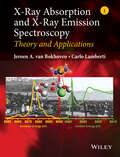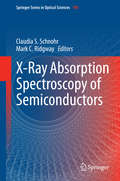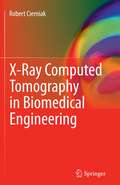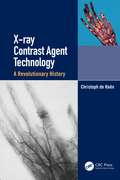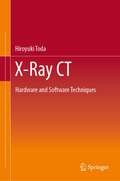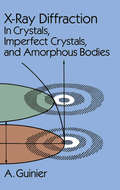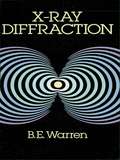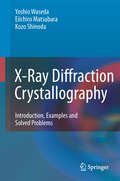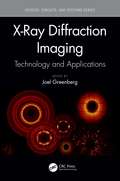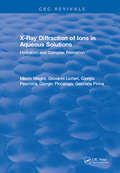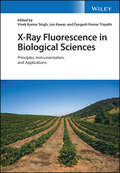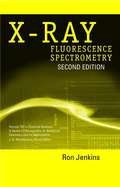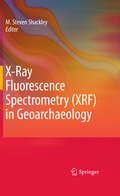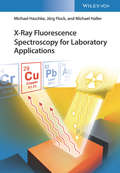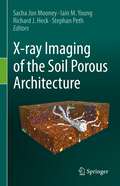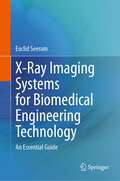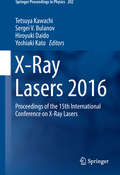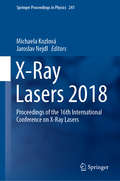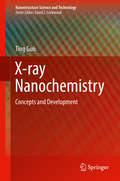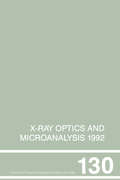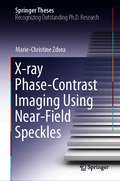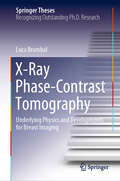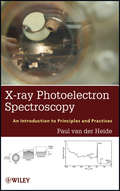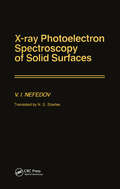- Table View
- List View
X-Ray Absorption and X-Ray Emission Spectroscopy
by Jeroen A. van Bokhoven Carlo LambertiDuring the last two decades, remarkable and often spectacular progress has been made in the methodological and instrumental aspects of x-ray absorption and emission spectroscopy. This progress includes considerable technological improvements in the design and production of detectors especially with the development and expansion of large-scale synchrotron reactors All this has resulted in improved analytical performance and new applications, as well as in the perspective of a dramatic enhancement in the potential of x-ray based analysis techniques for the near future. This comprehensive two-volume treatise features articles that explain the phenomena and describe examples of X-ray absorption and emission applications in several fields, including chemistry, biochemistry, catalysis, amorphous and liquid systems, synchrotron radiation, and surface phenomena. Contributors explain the underlying theory, how to set up X-ray absorption experiments, and how to analyze the details of the resulting spectra. X-Ray Absorption and X-ray Emission Spectroscopy: Theory and Applications: Combines the theory, instrumentation and applications of x-ray absorption and emission spectroscopies which offer unique diagnostics to study almost any object in the Universe. Is the go-to reference book in the subject for all researchers across multi-disciplines since intense beams from modern sources have revolutionized x-ray science in recent years Is relevant to students, postdocurates and researchers working on x-rays and related synchrotron sources and applications in materials, physics, medicine, environment/geology, and biomedical materials
X-Ray Absorption Spectroscopy of Semiconductors
by Claudia S. Schnohr Mark C. RidgwayX-ray Absorption Spectroscopy (XAS) is a powerful technique with which to probe the properties of matter, equally applicable to the solid, liquid and gas phases. Semiconductors are arguably our most technologically-relevant group of materials given they form the basis of the electronic and photonic devices that now so widely permeate almost every aspect of our society. The most effective utilisation of these materials today and tomorrow necessitates a detailed knowledge of their structural and vibrational properties. Through a series of comprehensive reviews, this book demonstrates the versatility of XAS for semiconductor materials analysis and presents important research activities in this ever growing field. A short introduction of the technique, aimed primarily at XAS newcomers, is followed by twenty independent chapters dedicated to distinct groups of materials. Topics span dopants in crystalline semiconductors and disorder in amorphous semiconductors to alloys and nanometric material as well as in-situ measurements of the effects of temperature and pressure. Summarizing research in their respective fields, the authors highlight important experimental findings and demonstrate the capabilities and applications of the XAS technique. This book provides a comprehensive review and valuable reference guide for both XAS newcomers and experts involved in semiconductor materials research.
X-Ray Computed Tomography in Biomedical Engineering
by Robert CierniakComputed Tomography gives a detailed overview of various aspects of computed tomography. It discusses X-ray CT tomography from a historical point of view, the design and physical operating principles of computed tomography apparatus, the algorithms of image reconstruction and the quality assessment criteria of tomography scanners. Algorithms of image reconstruction from projections, a crucial problem in medical imaging, are considered in depth. The author gives descriptions of the reconstruction methods related to tomography scanners with a parallel X-ray beam, trough solutions with fan-shaped beam and successive modifications of spiral scanners. Computed Tomography contains a dedicated chapter for those readers who are interested in computer simulations based on studies of reconstruction algorithms. The information included in this chapter will enable readers to create a simulation environment in which virtual tomography projections can be obtained in all basic projection systems. This monograph is a valuable study on computed tomography that will be of interest to advanced students and researchers in the fields of biomedical engineering, medical electronics, computer science and medicine.
X-ray Contrast Agent Technology: A Revolutionary History
by Christoph de HaenThis book documents the fascinating history of radiological techniques that use contrast agents. The text includes many of the fundamental documentary sources that bring to life the social and scientific background of the discoveries, the personalities of the discoverers, and implementation of new technologies. Such agents when used with X-rays allow clinicians to distinguish anatomical structures with nearly identical densities. Focus is on urological and angiographic uses of contrast agents. Key selling features: Documents and thoroughly references the history of contrast agent development Reviews the priority and importance of patents Discusses the role that important individual scientists and leading research institutions have played in technology development and implementation
X-Ray CT: Hardware and Software Techniques
by Hiroyuki TodaThis book provides easy-to-understand explanations to systematically and comprehensively describe the X-ray CT technologies, techniques, and skills used for industrial and scientific purposes. Included are many references along with photographs, figures, and equations prepared by the author. These features all facilitate the reader's gaining a deeper understanding of the topics being discussed. The book presents expertise not only on fundamentals but also about hardware, software, and analytical methods for the benefit of technical users. The book targets engineers, researchers, and students who are involved in research, development, design, and quality assurance in industry and academia.
X-Ray Diffraction: In Crystals, Imperfect Crystals, and Amorphous Bodies (Dover Books On Physics Series)
by A. GuinierThis valuable text begins with the general theory of diffraction through the use of Fourier transforms. The author then applies the general results to various atomic structures including amorphous bodies, crystals, and imperfect crystals, whereby the elementary laws of x-ray diffraction from ideal structures follow as a special case. The presentation has been carefully developed to illustrate clearly the meaning of the general equations essential for the study of more complex cases.Readers are assumed to be familiar with the elements of crystallography and x-ray diffraction, and the author has not discussed the problem of determining crystal structures. Rather the focus is on the great variety of imperfect crystals as well as amorphous bodies and liquids. The book should thus be especially useful solid-state physicists, materials scientists, chemists, and biologists with an interest in the scattering from defective structures. More generally, it will benefit all who require a thorough understanding of diffraction theory in order to interpret properly the information provided by modern x-ray diffraction instruments on line profiles, line intensities, diffuse scattering and other phenomena associated with disorder.
X-Ray Diffraction
by B. E. WarrenBasic diffraction theory has numerous important applications in solid-state physics and physical metallurgy, and this graduate-level text is the ideal introduction to the fundamentals of the discipline. Development is rigorous (throughout the book, the treatment is carried far enough to relate to experimentally observable quantities) and stress is placed on modern applications to nonstructural problems such as temperature vibration effects, order-disorder phenomena, crystal imperfections, the structure of amorphous materials, and the diffraction of x-rays in perfect crystals.Carefully selected problems have been included at the end of each chapter to help the student test his grasp of the material.
X-Ray Diffraction Crystallography
by Eiichiro Matsubara Kozo Shinoda Yoshio WasedaX-ray diffraction crystallography for powder samples is a well-established and widely used method. It is applied to materials characterization to reveal the atomic scale structure of various substances in a variety of states. The book deals with fundamental properties of X-rays, geometry analysis of crystals, X-ray scattering and diffraction in polycrystalline samples and its application to the determination of the crystal structure. The reciprocal lattice and integrated diffraction intensity from crystals and symmetry analysis of crystals are explained. To learn the method of X-ray diffraction crystallography well and to be able to cope with the given subject, a certain number of exercises is presented in the book to calculate specific values for typical examples. This is particularly important for beginners in X-ray diffraction crystallography. One aim of this book is to offer guidance to solving the problems of 90 typical substances. For further convenience, 100 supplementary exercises are also provided with solutions. Some essential points with basic equations are summarized in each chapter, together with some relevant physical constants and the atomic scattering factors of the elements.
X-Ray Diffraction Imaging: Technology and Applications (Devices, Circuits, and Systems)
by Joel GreenbergThis book explores novel methods for implementing X-ray diffraction technology as an imaging modality, which have been made possible through recent breakthroughs in detector technology, computational power, and data processing algorithms. The ability to perform fast, spatially-resolved X-ray diffraction throughout the volume of a sample opens up entirely new possibilities in areas such as material analysis, cancer diagnosis, and explosive detection, thus offering the potential to revolutionize the fields of medical, security, and industrial imaging and detection. Featuring chapters written by an international selection of authors from both academia and industry, the book provides a comprehensive discussion of the underlying physics, architectures, and applications of X-ray diffraction imaging that is accessible and relevant to neophytes and experts alike. Teaches novel methods for X-ray diffraction imaging Comprehensive and self-contained discussion of the relevant physics, imaging techniques, system components, and data processing algorithms Features state-of-the-art work of international authors from both academia and industry. Includes practical applications in the medical, industrial, and security sectors
X-Ray Diffraction of Ions in Aqueous Solutions: Hydration And Complex Formation
by Mauro Magini Giovanni Licheri Giorgio Paschina Giorgio Piccaluga Gabriella PinnaFirst Published in 2018. This book is devoted to the description of the basic principles of X-ray diffraction on noncrystalline systems and to the correlation between diffracted intensities and structure. It presents a critical comparison between the results obtained by XRD and the ones obtained by neutron diffraction.
X-Ray Fluorescence in Biological Sciences: Principles, Instrumentation, and Applications
by Vivek Kumar Singh Jun Kawai Durgesh Kumar TripathiX-Ray Fluorescence in Biological Sciences Discover a comprehensive exploration of X-ray fluorescence in chemical biology and the clinical and plant sciences In X-Ray Fluorescence in Biological Sciences: Principles, Instrumentation, and Applications, a team of accomplished researchers delivers extensive coverage of the application of X-ray fluorescence (XRF) in the biological sciences, including chemical biology, clinical science, and plant science. The book also explores recent advances in XRF imaging techniques in these fields. The authors focus on understanding and investigating the intercellular structures and metals in plant cells, with advanced discussions of recently developed micro-analytical methods, like energy dispersive X-ray fluorescence spectrometry (EDXRF), total reflection X-ray fluorescence spectrometry (TXRF), micro-proton induced X-ray emission (micro-PIXE), electron probe X-ray microanalysis (EPXMA), synchrotron-based X-ray fluorescence microscopy (SXRF, SRIXE, or micro-XRF) and secondary ion mass spectrometry (SIMS). With thorough descriptions of protocols and practical approaches, the book also includes: A thorough introduction to the historical background and fundamentals of X-ray fluorescence, as well as recent developments in X-ray fluorescence analysis Comprehensive explorations of the general properties, production, and detection of X-rays and the preparation of samples for X-ray fluorescence analysis Practical discussions of the quantification of prepared samples observed under X-ray fluorescence and the relation between precision and beam size and sample amount In-depth examinations of wavelength-dispersive X-ray fluorescence and living materials Perfect for students and researchers studying the natural and chemical sciences, medical biology, plant physiology, agriculture, and botany, X-Ray Fluorescence in Biological Sciences: Principles, Instrumentation, and Applications will also earn a place in the libraries of researchers at biotechnology companies.
X-Ray Fluorescence Spectrometry
by Ron JenkinsX-ray fluorescence spectroscopy, one of the most powerful and flexible techniques available for the analysis and characterization of materials today, has gone through major changes during the past decade.Fully revised and expanded by 30%, X-Ray Fluorescence Spectrometry, Second Edition incorporates the latest industrial and scientific trends in all areas. It updates all previous material and adds new chapters on such topics as the history of X-ray fluorescence spectroscopy, the design of X-ray spectrometers, state-of-the-art applications, and X-ray spectra.Ron Jenkins draws on his extensive experience in training and consulting industry professionals for this clear and concise treatment, covering first the basic aspects of X rays, then the methodology of X-ray fluorescence spectroscopy and available instrumentation. He offers a comparison between wavelength and energy dispersive spectrometers as well as step-by-step guidelines to X-ray spectrometric techniques for qualitative and quantitative analysis-from specimen preparation to real-world industrial application.Favored by the American Chemical Society and the International Centre for Diffraction Data, X-Ray Fluorescence Spectrometry, Second Edition is an ideal introduction for newcomers to the field and an invaluable reference for experienced spectroscopists-in chemical analysis, geology, metallurgy, and materials science.An up-to-date review of X-ray spectroscopic techniques. This proven guidebook for industry professionals is thoroughly updated and expanded to reflect advances in X-ray analysis over the last decade. X-Ray Fluorescence Spectrometry, Second Edition includes:* The history of X-ray fluorescence spectrometry-new to this edition.* A critical review of the most useful X-ray spectrometers.* Techniques and procedures for quantitative and qualitative analysis.* Modern applications and industrial trends.* X-ray spectra-new to this edition.
X-Ray Fluorescence Spectrometry (XRF) in Geoarchaeology
by M. Steven ShackleySince the 1960s, x-ray fluorescence spectrometry (XRF), both wavelength and energy-dispersive have served as the workhorse for non-destructive and destructive analyses of archaeological materials. Recently eclipsed by other instrumentation such as LA-ICP-MS, XRF remains the mainstay of non-destructive chemical analyses in archaeology, particularly for volcanic rocks, and most particularly for obsidian. In a world where heritage and repatriation issues drive archaeological method and theory, XRF remains an important tool for understanding the human past, and will remain so for decades to come. Currently, there is no comprehensive book in XRF applications in archaeology at a time when the applications of portable XRF and desktop XRF instrumentation are exploding particularly in anthropology and archaeology departments worldwide. The contributors to this volume are the experts in the field, and most are at the forefront of the newest applications of XRF to archaeological problems. It covers all relevant aspects of the field for those using the newest XRF technologies to deal with very current issues in archaeology.
X-Ray Fluorescence Spectroscopy for Laboratory Applications
by Michael Haschke Jörg Flock Michael HallerProvides comprehensive coverage on using X-ray fluorescence for laboratory applications This book focuses on the practical aspects of X-ray fluorescence (XRF) spectroscopy and discusses the requirements for a successful sample analysis, such as sample preparation, measurement techniques and calibration, as well as the quality of the analysis results. X-Ray Fluorescence Spectroscopy for Laboratory Applications begins with a short overview of the physical fundamentals of the generation of X-rays and their interaction with the sample material, followed by a presentation of the different methods of sample preparation in dependence on the quality of the source material and the objective of the measurement. After a short description of the different available equipment types and their respective performance, the book provides in-depth information on the choice of the optimal measurement conditions and the processing of the measurement results. It covers instrument types for XRF; acquisition and evaluation of X-Ray spectra; analytical errors; analysis of homogeneous materials, powders, and liquids; special applications of XRF; process control and automation. An important resource for the analytical chemist, providing concrete guidelines and support for everyday analyses Focuses on daily laboratory work with commercially available devices Offers a unique compilation of knowledge and best practices from equipment manufacturers and users Covers the entire work process: sample preparation, the actual measurement, data processing, assessment of uncertainty, and accuracy of the obtained results X-Ray Fluorescence Spectroscopy for Laboratory Applications appeals to analytical chemists, analytical laboratories, materials scientists, environmental chemists, chemical engineers, biotechnologists, and pharma engineers.
X-ray Imaging of the Soil Porous Architecture
by Sacha Jon Mooney Iain M. Young Richard J. Heck Stephan PethThe advent of X-ray Computed Tomography (CT) as a tool for the soil sciences almost 40 years ago has revolutionised the field. Soil is the fragile, thin layer of material that exists above earth’s geological substrates upon which so much of life on earth depends. However a major limitation to our understanding of how soils behave and function is due to its complex, opaque structure that hinders our ability to assess its porous architecture without disturbance. X-ray imagery has facilitated the ability to truly observe soil as it exists in three dimensions and across contrasting spatial and temporal scales in the field in an undisturbed fashion. This book gives a comprehensive overview of the “state of the art” in a variety of application areas where this type of imaging is used, including soil water physics and hydrology, agronomic management of soils, and soil-plant-microbe interactions. It provides the necessary details for entry level readers in the crucial areas of sample preparation, scanner optimisation and image processing and analysis. Drawing on experts across the globe, from both academia and industry, the book covers the necessary “dos and don’ts”, but also offers insights into the future of both technology and science. The wider application of the book is provided by dedicated chapters on how the data from such imagery can be incorporated into models and how the technology can be interfaced with other relevant technical applications. The book ends with a future outlook from the four editors, each of whom has over 20 years of experience in the application of X-ray CT to soil science.
X-Ray Imaging Systems for Biomedical Engineering Technology: An Essential Guide
by Euclid SeeramThis book addresses X-Ray Imaging Systems intended for biomedical engineering technology students and practitioners, and deals with the major technical components of x-ray imaging modalities. These modalities include film-based imaging, digital radiography, and computed tomography. Furthermore, principles and concepts essential to the understanding of how these modalities function will be described. These include fundamental radiation physics, imaging informatics, quality control, and radiation protection considerations. X-Ray Imaging Systems for Biomedical Engineering Technology: An Essential Guide is intended for biomedical engineering technologists, who provide technical advice and services relating to digital radiography and CT departments not only in hospitals but in private facilities as well. Students in radiological technology programs may also find this to be a useful resource.
X-Ray Lasers 1996: Proceedings of the Fifth International Conference on X-Ray Lasers held in Lund, Sweden, 10-14 June, 1996
by S Svanberg; C-G WahlströmX-Ray Lasers 1996 provides not only an overview and progress report on this fast moving field, but also important reference material on which future work can be built. Topics covered include collisional x-ray lasers, table-top x-ray lasers, beam optics, x-ray optics, OFI and photo-pumped schemes, capillary schemes, international laser facilities, XUV nonlinear mixing, alternative soft x-ray sources, diagnostics, and applications. The volume is an essential addition to the libraries of researchers in the field.
X-Ray Lasers 2016: Proceedings Of The 15th International Conference On X-ray Lasers (Springer Proceedings In Physics #202)
by Tetsuya Kawachi Sergei V. Bulanov Hiroyuki Daido Yoshiaki KatoDiscusses the latest research topics related to coherent x-ray sources.<P><P> Includes several new proposals for free-electron laser (FEL) using laser- accelerated electrons.<P> Describes the latest methodology and techniques for x-ray coherent diffraction imaging and x-ray interferometry.<P> These proceedings comprise a selection of invited and contributed papers presented at the 15th International Conference on X-Ray Lasers (ICXRL 2016), held at the Nara Kasugano International Forum, Japan, from May 22 to 27, 2016. This conference was part of an ongoing series dedicated to recent developments in the science and technology of x-ray lasers and other coherent x-ray sources with additional focus on supporting technologies, instrumentation and applications. <P> The book showcases recent advances in the generation of intense, coherent x-rays, the development of practical devices and their applications across a wide variety of fields. It also discusses emerging topics such as plasma-based x-ray lasers, 4th generation accelerator-based sources and higher harmonic generations, as well as other x-ray generation schemes.
X-Ray Lasers 2018: Proceedings of the 16th International Conference on X-Ray Lasers (Springer Proceedings in Physics #241)
by Michaela Kozlová Jaroslav NejdlThese proceedings gather a selection of invited and contributed papers presented during the 16th International Conference on X-Ray Lasers (ICXRL 2018), held in Prague, Czech Republic, from 7 to 12 October 2018. The conference is part of an ongoing series dedicated to recent developments in the science and technology of X-ray lasers and other coherent X-ray sources, with an additional focus on supporting technologies, instrumentation and applications. The book highlights advances in a wide range of fields including laser and discharge-pumped plasma X-ray lasers, the injection and seeding of X-ray amplifiers, high-order harmonic generation and ultrafast phenomena, X-ray free electron lasers, novel schemes for (in)coherent XUV, X-ray and γ-ray generation, XUV and X-ray imaging, optics and metrology, X-rays and γ-rays for fundamental science, the practical implementation of X-ray lasers, XFELs and super-intense lasers, and the applications and industrial uses of X-ray lasers.
X-ray Nanochemistry: Concepts And Development (Nanostructure Science And Technology Ser.)
by Ting GuoThis book describes the latest developments in the new research discipline of X-ray nanochemistry, which uses nanomaterials to enhance the effectiveness of X-ray irradiation. Nanomaterials now can be synthesized in such a way as to meet the demand for complex functions that enhance the X-ray effect. Innovative methods of delivering the X-rays, which can interact with those nanomaterials much more strongly than energetic electrons and gamma rays, also create new opportunities to enhance the X-ray effect. As a result, new concepts are conceived and new developments are made in the last decade, which are discussed and summarized in this book. This book will help define the discipline and encourage more students and scientists to work in this discipline. These efforts will eventually lead to formation of a full set of physical, chemical and materials principles for this new research field.
X-Ray Optics and Microanalysis 1992, Proceedings of the 13th INT Conference, 31 August-4 September 1992, Manchester, UK
by P.B. Kenway P.J. DukeThe first ICXOM congress held in Cambridge was the brain-child of Dr. Ellis Cosslett, founder of the Electron Optics Section of the Cavendish Laboratory. Dr. Cosslett pioneered research in x-ray optics and microanalysis and retained a close interest in all subject applications for this area of research, including physics, materials science, chemistry, and biology. X-Ray Optics and Microanalysis 1992 was held in his memory. At a special symposium, friends and colleagues reviewed the present status of research in x-ray optics and microanalysis. S.J. Pennycook of Oak Ridge National Laboratory, D.B. Williams of Lehigh University, J.A. Venables et al. of Arizona State University and Sussex University, and C. Jacobsen et al. of SUNY, Stony Brook are among the researchers whose papers are included in this volume.
X-ray Phase-Contrast Imaging Using Near-Field Speckles (Springer Theses)
by Marie-Christine ZdoraThis thesis presents research on novel X-ray imaging methods that improve the study of specimens with small density differences, revealing their inner structure and density distribution. Exploiting the phase shift of X-rays in a material can significantly increase the image contrast compared to conventional absorption imaging. This thesis provides a practical guide to X-ray phase-contrast imaging with a strong focus on X-ray speckle-based imaging, the most recently developed phase-sensitive method. X-ray speckle-based imaging only requires a piece of abrasive paper in addition to the standard X-ray imaging setup. Its simplicity and robustness combined with the compatibility with laboratory X-ray sources, make it an ideal candidate for wide user uptake in a range of fields. An in-depth overview of the state of the art of X-ray speckle-based imaging and its latest developments is given in this thesis. It, furthermore, explores a broad range of applications, from X-ray optics characterisation, to biomedical imaging for 3D virtual histology and geological studies of volcanic rocks, demonstrating is promising potential. Moreover, the speckle-based technique is placed in the context of other phase-sensitive X-ray imaging methods to assist in the choice of a suitable method, hence serving as a guide and reference work for future users.
X-Ray Phase-Contrast Tomography: Underlying Physics and Developments for Breast Imaging (Springer Theses)
by Luca BrombalX-ray imaging is a corner stone of breast cancer diagnosis. By exploiting the phase shift of X-rays rather than their attenuation, phase-contrast tomography has the potential to dramatically increase the visibility of small and low contrast features, thus leading to better diagnosis. This thesis presents research on the first synchrotron-based project developing a clinical phase-contrast breast computed tomography (CT) setup at Elettra, the Italian Syncrotron Radiation Facility. This book includes a comprehensive theoretical background on propagation-based phase-contrast imaging, exploring and extending the most recent image formation models. Along with theory, many practical implementation and optimization issues, ranging from detector-specific processing to setup geometry, are tackled on the basis of a large number of experimental evidences. Most of the modelling results and data analysis have general validity, being a valuable framework for optimization of phase-contrast setups. Results obtained at synchrotron are also compared with "real world" laboratory sources: both a first-of-its-kind comparison with one of the few hospital breast CT systems and a state-of-the-art implementation of monochromatic phase-contrast micro-tomography with a conventional rotating anode source are presented. On a more general level, this work sheds a light on the importance of synchrotron-based clinical programs, which are key to trigger the long-anticipated transition of phase-contrast imaging from synchrotrons to hospitals.
X-ray Photoelectron Spectroscopy
by Paul van der HeideThis book introduces readers interested in the field of X-ray Photoelectron Spectroscopy (XPS) to the practical concepts in this field. The book first introduces the reader to the language and concepts used in this field and then demonstrates how these concepts are applied. Including how the spectra are produced, factors that can influence the spectra (all initial and final state effects are discussed), how to derive speciation, volume analysed and how one controls this (includes depth profiling), and quantification along with background substraction and curve fitting methodologies. This is presented in a concise yet comprehensive manner and each section is prepared such that they can be read independently of each other, and all equations are presented using the most commonly used units. Greater emphasis has been placed on spectral understanding/interpretation. For completeness sake, a description of commonly used instrumentation is also presented. Finally, some complementary surface analytical techniques and associated concepts are reviewed for comparative purposes in stand-alone appendix sections.
X-Ray Photoelectron Spectroscopy of Solid Surfaces
by V.I. NefedovThis volume outlines the physical and methodical concepts of X-ray photoelectron spectroscopy (XPS) specifically for surface studies using both inner and valence electron levels. It discusses the theory and practice of XPS qualitative and quantitative analysis of solid state surfaces and provides lists of extended experimental and theoretical data necessary for the determination of concentration and thin film thicknesses. In addition it covers the many problems concerning in-depth profiling, ion sputtering rate and damages of the structure of altered layers, as well as applications of angular dependence of the intensities and photoelectron diffraction for surface studies. Also provided are the applications of XPS for the investigations of catalysts, adsorption, electronic surface states, oxydation of semi-conductors and alloys, minerals, including lunar regolith and natural gold, glasses, radiation damage, surface diffusion, polymers, etc.
